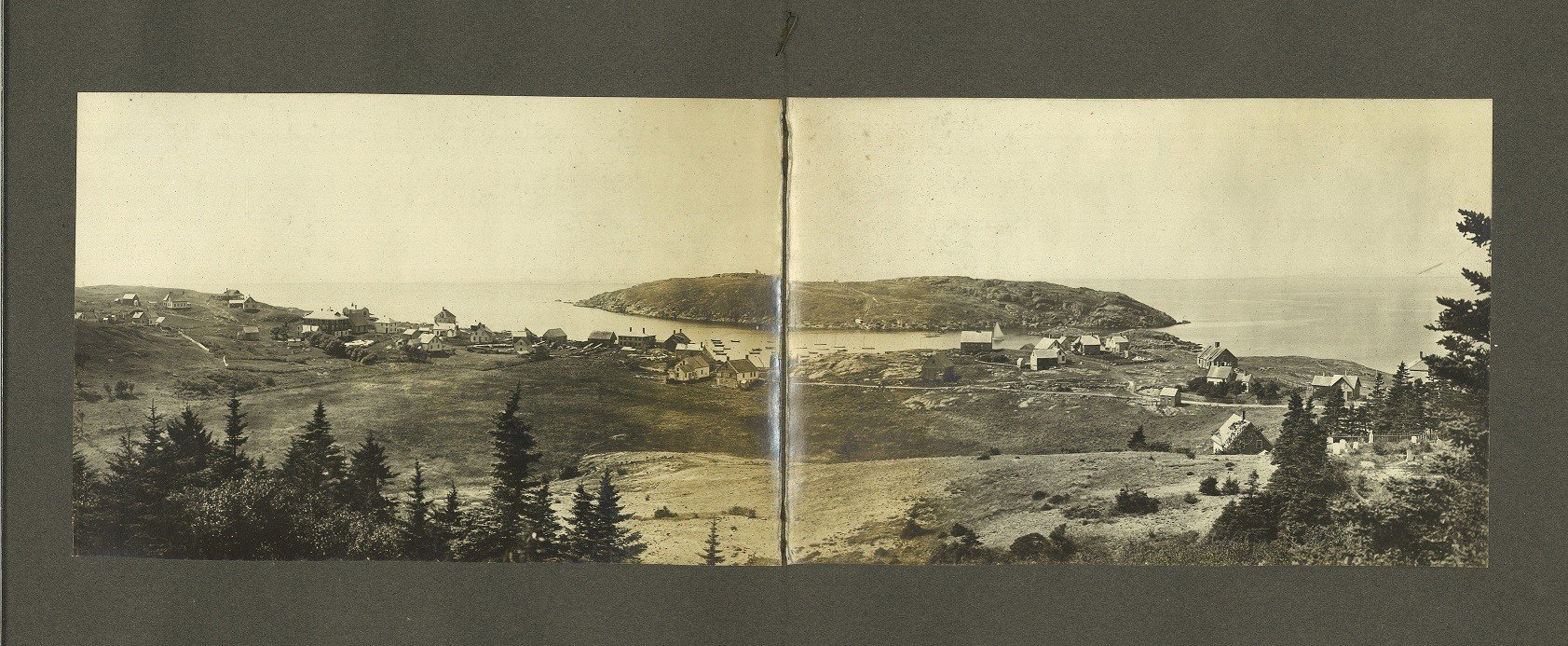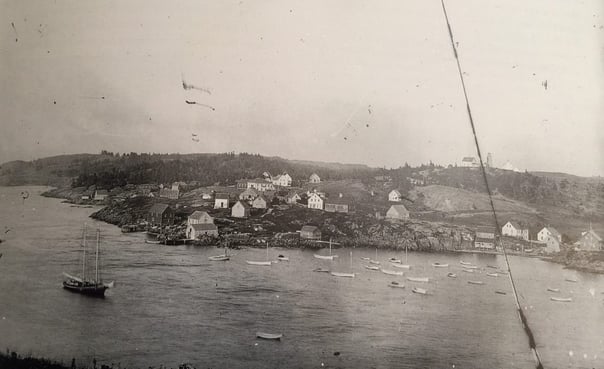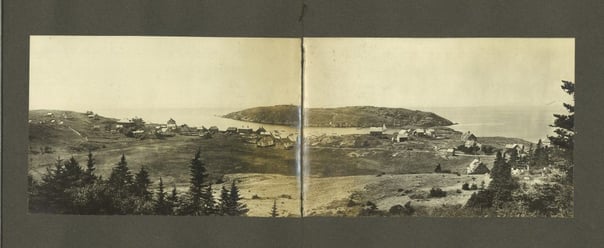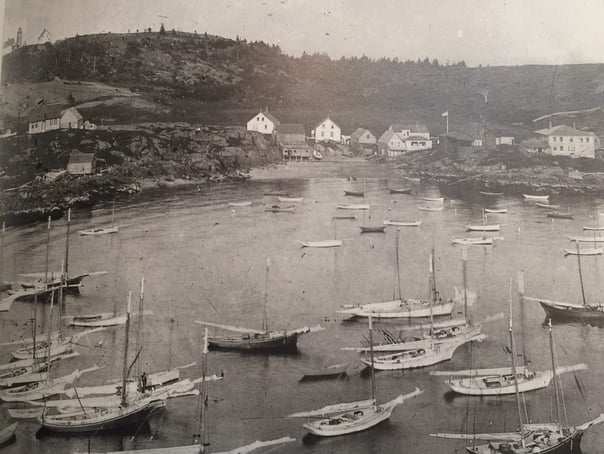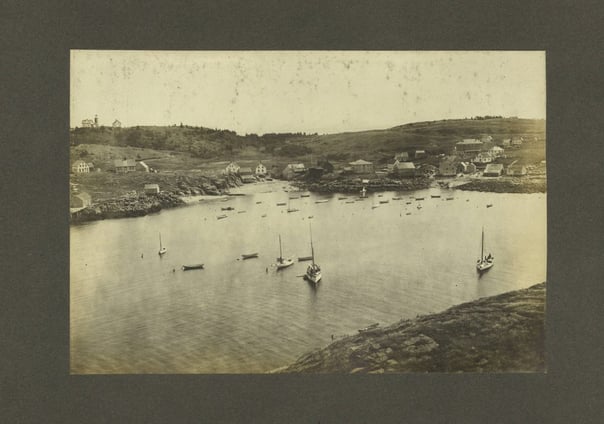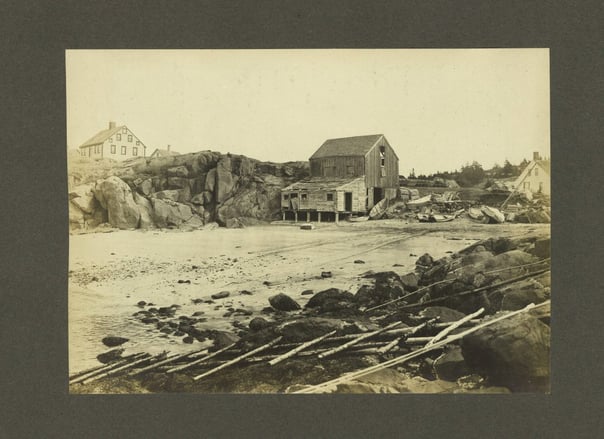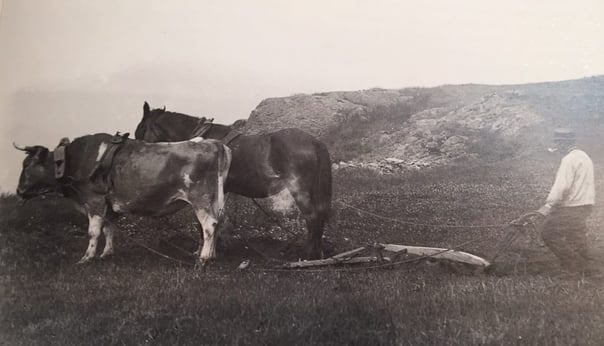After my photo album puzzle was solved within what seemed like minutes of being posted (thank you, everyone!), I did some quick research: Monhegan records around 1900 contained none of my husband’s family names. Seems likely his ancestor was just another visitor to the island – a tourist who was also a talented photographer, or who appreciated the skills of a photographer who, like many artists, was drawn to the beauty of Monhegan. Still, the images in the little album drew me in. I wanted to know more about this island situated twelve nautical miles off the coast of Boothbay, Maine.
In the library, I found a wonderful book called An Eye for the Coast: The Maritime and Monhegan Island Photographs of Eric Hudson by Earle G. Shettleworth Jr. and W. H. Bunting (Gardiner, Maine: Tilbury House, 1998). The foreword was by the artist Jamie Wyeth, who kept a house there. Wyeth calls Monhegan “the most visited, the most photographed, and the most painted island in all of Maine’s archipelago.” Were my photos Hudson photos? I shared my images with Tara Hire at the Monhegan Museum of Art & History, who confirmed they were from the early 1900s but said they do not look like Hudson’s work. She also checked their genealogy database and confirmed that my husband’s ancestors had not lived there.
Shettleworth and Bunting’s book takes an interesting approach: then director of the Maine Historic Preservation Commission, Shettleworth remarks mostly on the buildings and their history, while Bunting provides amazing expert commentary on the maritime vessels and fishing practices of the time. (In fact, some of Hudson’s photos are the only remaining records of certain types of ships.) I thought it’d be fun to use their book to see what I could learn about my album.
My “panorama” shows Manana Island. I was correct in thinking it was taken from the lighthouse atop Monhegan Island, across the harbor. (The Monhegan Museum is now housed in the lighthouse buildings.) I also learned that the contraption just right of center on Manana is the trolleyway that was used to transport coal and supplies to the U.S. Lighthouse Service’s Fog Signal Station. Regarding the graveyard visible at right, Bunting and Shettleworth (citing Charles B. McLane’s Islands of the Mid-Maine Coast, vol. III) say the oldest stone is for Phebe Starling, d. 1784.
In Hudson’s image (above) on page 115 of An Eye for the Coast, the dark-hulled schooner is Captain Will Humphrey’s packet Effort, which delivered mail and supplies and maintained a critical dependable link to the mainland. On page 106, Bunting shares two stories to illustrate Humphrey’s superb skills as a seaman. Humphrey is said to have ridden out the Portland Gale of November 1898 in the lee of Manana, his wife catching glimpses of Effort’s sails in the beams of the lighthouse. Another time, Humphrey couldn’t resist claiming another vessel’s lost lumber on a glassy-calm day. After he’d gotten into his dory to fetch the lumber, a breeze kicked up and filled his schooner’s sails. He finally caught her with a boathook after a vigorous seven-mile pursuit.
On page 117 of Bunting and Shettleworth, Hudson’s view (above) of what I now know is Swim Beach is so eerily similar to mine that at first I thought the two photographers had been there on the same day! Then I carefully checked each building along the shore and found two items missing from my view: just right of center, my dark-colored building has no flag and no shed between it and the house with the porch next door. It also looks as if that neighbor got busy and painted the fence behind his big hip-roofed house by the time Hudson took his photo!
Shettleworth identifies the building second from left in my view as the Josiah Starling Jr. house – in 1998, part of the Island Inn. Above the beach are the Josiah Starling Sr. house, the Starling Fish House, and the George Trefethren house. The dark-colored building (now known as “The Red House”) is the 1784 Henry Trefethren house. The hip-roofed, Federal-style building to its right was also built by Henry Trefethren in 1826; he lived on one side and his son lived on the other. This big house was known at the time as “The Influence” (as in “Bad”). Bunting and Shettleworth share two theories for how it got the name: it was where the men gathered to play poker, and the cellar was well stocked with barrels of rum – it seems quite possible that both stories are true! Next to The Influence, looming above Fish Beach, is the grand multi-story Albee House hotel, known in 1998 as the New Monhegan House.
It turns out the eight windows in the house at left in my image belong to a side wall of the Josiah Starling Jr. house. I wasn’t able to figure out from An Eye for the Coast which of the many fish houses is in the foreground.
In 1850 there were several oxen, a few dozen cows, and 150 sheep on the island, but there was reportedly only one horse. He was used as needed by any of the islanders; they simply had to visit his owner to get his harness. Here, from page 167, he is seen plowing with an unlikely partner.
There was also only one road on Monhegan. And the men were so intent on one thing – fishing – that Bunting says they were described as being incapable of doing anything else. One story tells of a day when a group of men were dividing up the proceeds from a recent venture when the signal sounded indicating someone had spotted mackerel. The men hastily stuffed a few bills in their pockets and ran to their boats, leaving several hundred dollars for the children to scoop up. They probably brought their “catch” home to their mothers, who would use the windfall to help run the household. While the men fished, the women of Monhegan tended to their children and to guests in a growing summer lodging business.
Beginning in the late 1800s, the community would grow with painters and photographers and vacationers “from away” every summer. Bunting reports that, unlike many small fishing villages, Monhegan “natives” and summer people got along quite well, becoming friends and finding their differences more a source of amusement than irritation.
Sounds like a good place to take a boat ride to this summer…
Share this:

About Sharon Inglis
In nearly 30 years in the educational publishing industry, Sharon developed and directed the production of French, Spanish, Italian, German, social studies, science, and math textbook programs for secondary school and higher education. She is very happy to be at NEHGS and applying her editorial and project management skills to Newbury Street Press publications, theMayflower Descendant journal, and whatever else comes her way!View all posts by Sharon Inglis →
